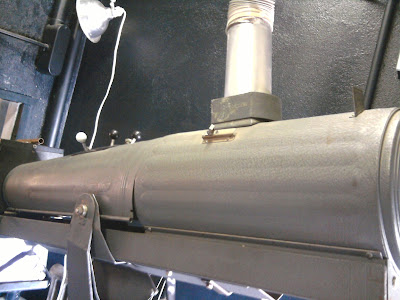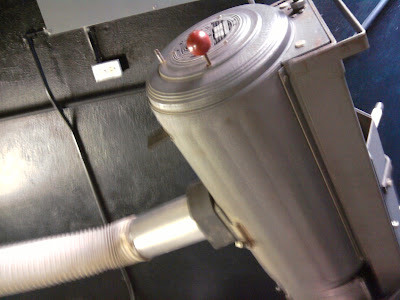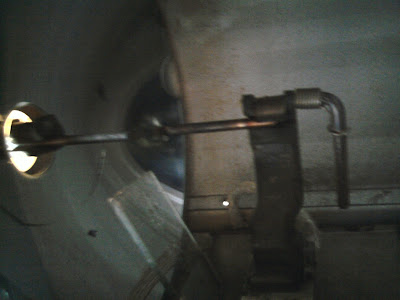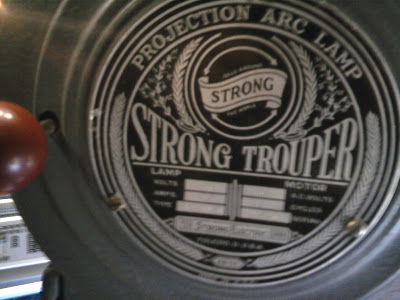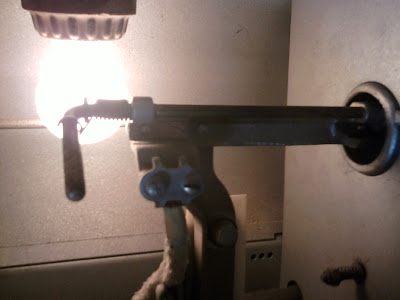Carbon arc, a deathtrap??? not so. if vented, actually a very safe, reliable workhorse. State of the art for many years. I have run many different types from the small Troupers to the giant Genarcos with positive carbons 24" long and as big around as a broom stick. I worked as a Strong Repair technician for a while in the early '70's, so I do have a small appreciation of the workings of the carbon arc light.
Back in the stone age, when I was in grad school I did a paper on "The Development of the Carbon Arc in the 19th Century". Went from battery powered, carbon arc furnaces used for carbide production and steel smelting, street lights in Paris, to back stage flood lights and then to FOH theatrical spot lights. They of course played a major role in both the World Wars as air raid search lights and then for many years were the beams of light you saw in the sky at openings of new movies, special events and such. Between 1820 and 1885 over 200 patents were issued for mechanisms to regulate or feed the carbons as they burned. One of the more interesting, the Jablokoff Candle, relied on a marvelous, controversial new development, alternating current. In the "normal" DC current supplied by a battery or later by dynamo, the positive carbon will burn away at about twice the rate of the negative. the Jablokoff candle, used extensively in street lights in Paris, took two carbons, side by side/parallel, insulated by a thin layer of kaolin or china clay. The alternating current burned the two carbons at equal rate, making the Jablokoff candle self regulating.
The real Death Trap was what the carbon arc replaced, the Lime Light. The lime light was produced by focusing an Oxygen-Acetylene flame (welding gas) onto a block of lime. The lime when heated, incandessed, producing a very bright light and our present slang term to "be in the Lime Light". And that was the real "Death Trap." Metal cylinders for gas did not exist yet, nor did gauges or regulators. The gas was contained in skin bags and the operator sat on the bags to produce and maintain proper pressure to produce a good flame. Explosions and fires were not uncommon.
So, what was that you said about that finely crafted piece of antique machinery?? Deathtrap!!! Not So!!
Michael Powers, Project Manager
ETCP Certified Rigger - Theatre
Central Lighting & Equipment Inc.
675 NE 45th Place, Des Moines,
Thanks to the above... got handed a phone call today from someone while on beak... Ship's standing right here... (there must have been a problem on a show site..)
It's the 1980's calling about your blue jean jacket... got kicked upside the shin once I realized the joke on me in a good harted way.
Sometimes at work get joked about as old school or old and I am perhaps as compared to most I at times could be their dad of. Here I am advocating 400' ethernet wire six channel DMX and two channel Clear Com snakes for use, but still also holding onto the concept that the 360 or 360Q isn't a useless fixure. This much less beyond being the LED fab guy for many projects, I also specialize in antique fixtures or wiring. No I have no idea of how to work a modern light board or how to change a lamp on a fixture - could figure it out, but not my specilization. Instead me knowing how a strip light works is more useful at times with other older design concepts.
Anyway, thanks the above carbon arc operators for not making me feel as aged in experience in that while I wouldn't pass up such fixtures, I came to the industry at a time after them. This and with my own breadth of experience your own is none shorted in being also well experienced in a way so as to form an opinion. This as opposed to those po, pooing such things as ... Not S-4... how ancient, I cannot design with this crap. And we gotta have moving lights in our high school because if I at 16 years old and don't have experience with one after only say two years experience in the theater industry I'm missing out. Carbon arc... they are on my list to collect and learn.
By the way MPowers, given this was a Graduate School paper, it's no doubt worth publishing here for all to learn from and a perminant record of what you found. Any cance of you contacting the Webmaster Dave in having him place your paper somewhere say in an upcoming reference library for others to use and learn from in the future? ISU and Elmhurst college had a lot of books for me to learn from in the past, since than I have bought many of those books I learned from. Not all places have such librarys available and I don't know to what extent books at this point have been put on line. As with my 1916 Chicago Stage Lighting catalogue that's now at least out there and available, any chance on your own paper becoming available as with others in high level research on subects?
Last edited:




